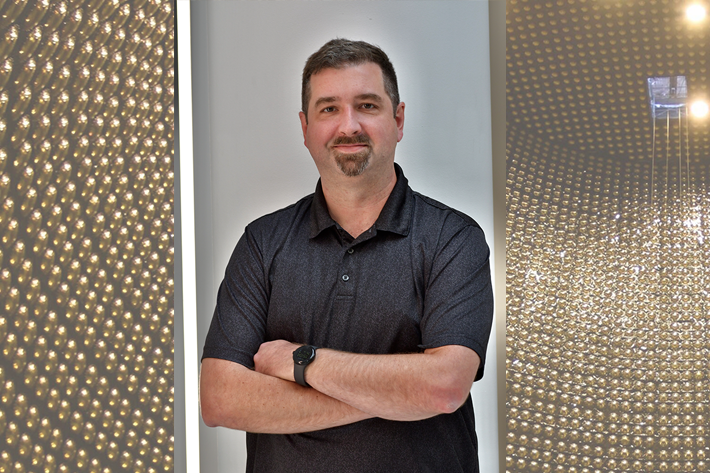Moving Target: New Faculty member does neutrino research with a twist

Professor Michael Wilking is a new faculty member in high energy physics. Wilking’s research is focused on neutrinos and he is a member of several international neutrino collaborations, including DUNE (Deep Underground Neutrino Experiment). The multi-billion dollar physics experiment has a far detector which will be installed inside of massive caverns which are being dug a mile underground at the Sanford Underground Research Facility in Lead, SD. It will use a neutrino beam that originates at Fermilab. Wilking is working on a prototype for the near detector that will have a novel new feature –movability. Making the detector mobile will allow the physicists to sample a multitude of different neutrino energies naturally provided by the neutrino beam. These “off-axis” measurements provide the additional critical information needed to relate the signals seen in their detectors to the true underlying energy of the incoming neutrino.
Wilking is also working on a prototype of the detector movement system, known as “DUNE-PRISM," in the Physics and Nanotechnology high bay. After a series of prototypes, the full system will be installed in the neutrino beam at Fermilab. “The beam makes the neutrinos, and the near detector measures the properties of the neutrinos before they’ve had a chance to oscillate,” Wilking says, “Nearly all the neutrinos will travel 800 miles to the far detector where the oscillation signature will be measured. Both detectors are needed to search for subtle differences between matter and antimatter.” DUNE’s near detector hall will begin excavation at Fermilab in 2026, and will be ready for detector installation in 2028. The start of science is 2031.
“We’ll be performing movement system R&D in the high bay this fall. We want to figure out how to operate the movement system, the first of its kind. All previous detector movement systems required teams of technicians and weeks of planning and execution to move such delicate, yet very massive, equipment. This system is designed to move the DUNE near detectors at least once a week.”
Wilking explains that moving the near detector is not merely convenient, the real reason to go to the trouble is for the physics. Neutrino beams are created by accelerating protons toward a long cylindrical target. The proton-target collisions produce charged pions, which are forward-focused and then allowed to decay to neutrinos. By changing that angle at which the near detector measures the beam, the observed neutrino energy changes. When looking straight along the beam axis, the detector sees the highest energy particles, but as you scan across increasingly off-axis positions, the neutrino energy decreases, and provides a mechanism to calibrate the particles observed in the detector to the true neutrino energy. “Previous long-baseline neutrino experiments were limited by their ability to precisely determine the energy of each neutrino. Since neutrino oscillation patterns are observed in the neutrino energy spectrum, this is the most critical quantity to measure correctly.”
Wilking’s research is not limited to DUNE. He also works on T2K and Super-Kamiokande experiments in Japan. T2K uses a beam of neutrinos sent from the east coast to the west coast of Japan, similar to the experimental layout of DUNE. Super-Kamiokande serves as the far detector for T2K, but it has also been measuring neutrinos produced in the atmosphere since 1996, which resulted in the original discovery of neutrino oscillations in 1998 and the Nobel Prize in physics in 2015. “I am co-leading a team of physicists from T2K and Super-Kamiokande to extract neutrino oscillation parameters from T2K beam neutrinos and Super-Kamiokande atmospheric neutrinos simultaneously. Our initial results were just released this month at an international conference in Procida, Italy.”
“Ultimately, the primary goal of T2K, Super-Kamiokande, and DUNE is to look for subtle differences in the behavior of matter and anti-matter, and neutrino oscillations are one of our most sensitive probes of these effects.” Wilking hopes that these experiments will shed light on these fundamental questions about our universe, provide precise measurements of the remaining unknown parameters of the standard model, and perhaps point the way to new physics beyond the standard model.